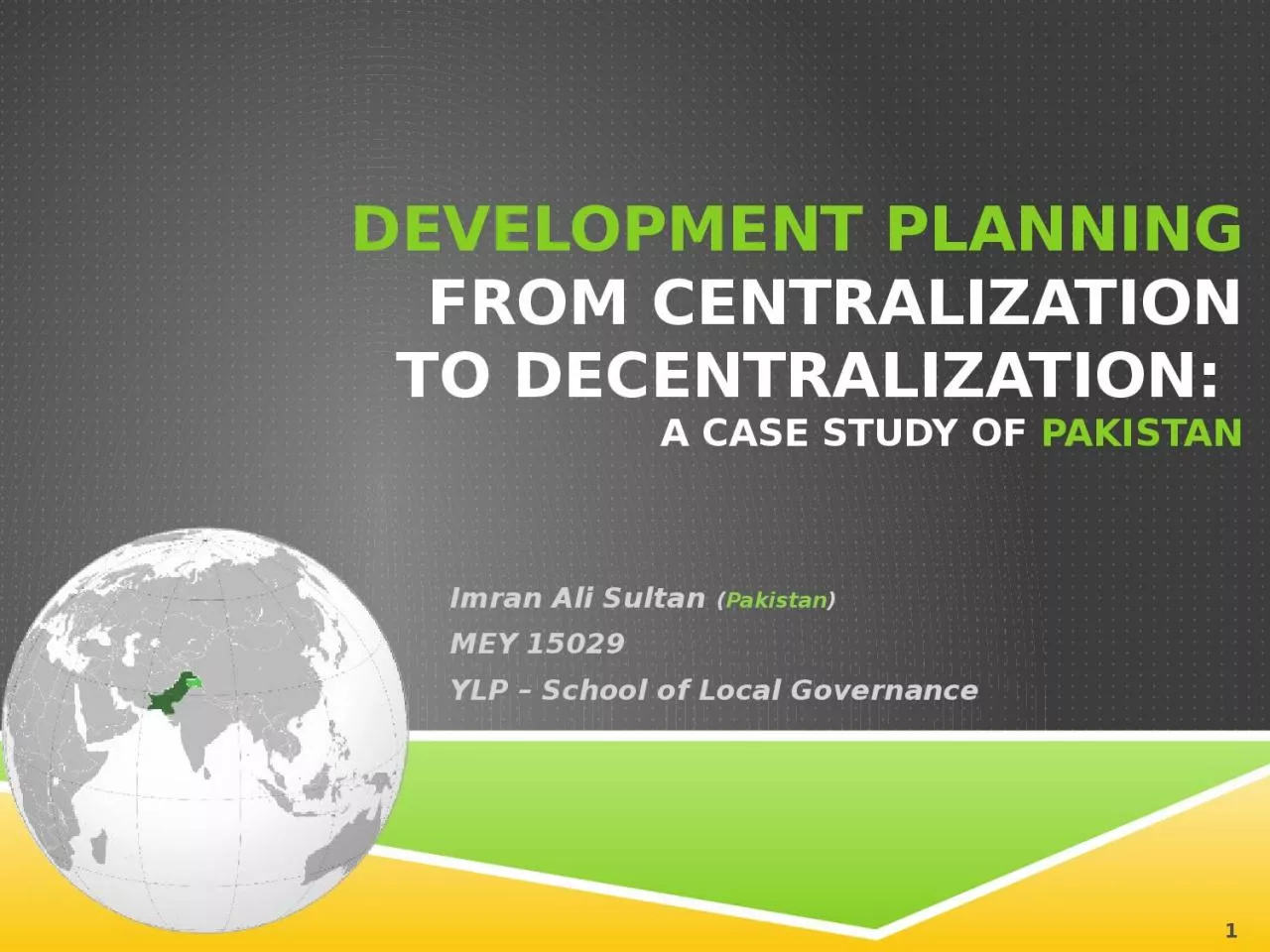

MEY 15029 YLP School of Local Governance Development Planning from centralization to decentralization A case study of Pakistan 1 Out line Pakistan an overview Centralized Development Planning ID: 1027945
Download Presentation The PPT/PDF document "Imran Ali Sultan ( Pakistan" is the property of its rightful owner. Permission is granted to download and print the materials on this web site for personal, non-commercial use only, and to display it on your personal computer provided you do not modify the materials and that you retain all copyright notices contained in the materials. By downloading content from our website, you accept the terms of this agreement.
1. Imran Ali Sultan (Pakistan)MEY 15029YLP – School of Local GovernanceDevelopment Planning from centralization to decentralization: A case study of Pakistan1
2. OutlinePakistan – an overviewCentralized Development PlanningKey FeaturesResultsAnalysisDecentralized Development Planning18th Constitutional Amendment – Empowering Provinces7th National Finance Commission AwardLocal Governments Devolution Plan 2000 Conclusion2
3. Centralized planning (1958-1969)3Five Years PlansSecond Five Year Plan (1960 – 1965)Third Five Year Plan (1965 – 1970)Focused AreasRapid IndustrializationAgriculture Mechanization / Industry
4. Centralized planning – resultsTheoretical Enthusiasm4YearGDP Growth Rate (%)19616.0119627.1919636.4819649.3819657.5619663.0819676.7919686.4919699.79Source: Federal Bureau of Statistics, Pakistan“The underdeveloped countries must consciously accept a philosophy of growth and shelve for the distant future all ideas of equitable distribution and welfare state.”(p. 30)Source: Ul Haq, M. (1963) The Strategy of Economic Planning: A Case Study of Pakistan, Karachi: Oxford University Press
5. Centralized planning – resultsSector% of Total Investment during 2nd Five Year Plan (1960-65)Water & Power32.2Transport & Communication20.4Housing & Settlement9.2Education & Training9.1Health & Social Welfare9.5Source: Azizur Rahman Khan (1961). Financing the Second Year Plan5
6. Perspective plan 1965 - 1985Key Areas6Universal EmploymentUniversal Education 8th GradeSource: Said Hasan (19xx) – Some Problems of Perspective Planning in Pakistan
7. Centralized planning – analysis7Subsidies and tariff protection to exportsExport Bonus VouchersElite Farming StrategyLand Reforms, Consolidation of Land HoldingsConcentrating income in upper income groupsTarget savings rate set at 25% of GDP
8. Centralized planning – conclusion8Income inequalityInefficient industrial baseLoan Dependence Mass movements against President East Pakistan --- Bangladesh
9. decentralized development planning18th Amendment in the Constitution (2010)7th NFC Award (effective since 2010)Local Government Devolution Plan 20009
10. 1. 18th Amendment in the Constitution (2010)10
11. 2. 7th NFC Award (effective since 2010)11
12. Decentralization in pakistan 12
13. operationalization13
14. measuring variables14
15. Decentralization of education15
16. Measuring decentralization 16
17. DECENTRALIZATION INDEX AND EDUCATION INDEXResearch Question:Does decentralization of education contribute in attaining higher education index?. Projection:Longitudinal (time horizon)Sources:UNDP – HDR (various), Author’s calculation and projectionSource: Mehmood & Sadiq (2010)17
18. Research Question:Does decentralization of education contribute in attaining higher education index?Null Hypothesis:Decentralization does not contribute in achieving human development. Sources:UNDP – HDR (various), Author’s calculation and projectionDECENTRALIZATION INDEX AND EDUCATION INDEX18
19. DECENTRALIZATION INDEX & HUMAN DEVELOPMENT INDEXHypothesis:Decentralization contribute in achieving human development. Sample:34 Districts in Punjab ProvinceSources:UNDP – HDR (2015), Ivanyna & Shah (2012), Jamal & Khan (2007), Author’s calculation and projection19
20. DECENTRALIZATION INDEX & EDUCATION INDEXSource: USAID (2008) – National Survey “The Local Government System: Citizens Perceptions and Preferences”20
21. DECENTRALIZATION AND HUMAN DEVELOPMENTSource: Akhtar (2008): Trends in Regional Inequalities in Pakistan: Evidence Since 199821
22. Direct democracy & citizen community boards (CCBs)22
23. POLICY challengesLack of OwnershipElite Capture Bureaucratic DissentPoor FinancesImplementation IssuesCorruption 23
24. conclusionSource: UNDP (2012) - Social Audit of Local Governance and Delivery of Public Services 2011 – 2012Methodology: Qualitative through 30 FGDs conducted in 8 selected districtsComparison of Local Government Systems Elected LGSAdministrative LGSHighModerateLowHighModerateLowAccessibility Responsiveness Service Delivery Addressing Needs Capacity Check & Balance Corruption Consultation Sense of Ownership 24